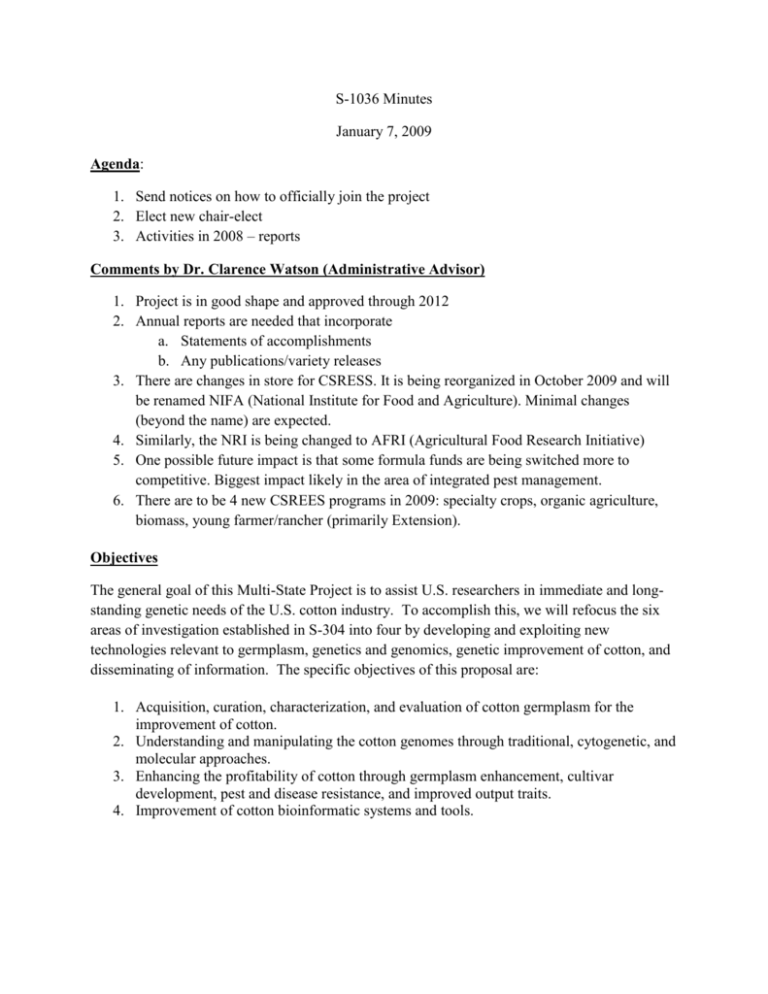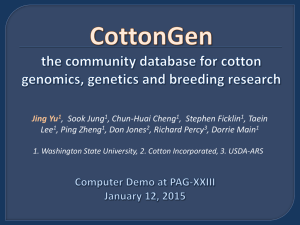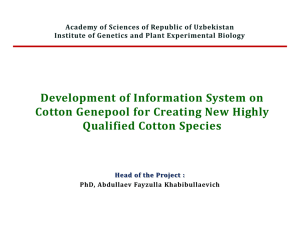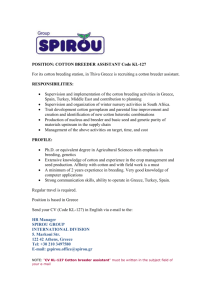Minutes
advertisement

S-1036 Minutes January 7, 2009 Agenda: 1. Send notices on how to officially join the project 2. Elect new chair-elect 3. Activities in 2008 – reports Comments by Dr. Clarence Watson (Administrative Advisor) 1. Project is in good shape and approved through 2012 2. Annual reports are needed that incorporate a. Statements of accomplishments b. Any publications/variety releases 3. There are changes in store for CSRESS. It is being reorganized in October 2009 and will be renamed NIFA (National Institute for Food and Agriculture). Minimal changes (beyond the name) are expected. 4. Similarly, the NRI is being changed to AFRI (Agricultural Food Research Initiative) 5. One possible future impact is that some formula funds are being switched more to competitive. Biggest impact likely in the area of integrated pest management. 6. There are to be 4 new CSREES programs in 2009: specialty crops, organic agriculture, biomass, young farmer/rancher (primarily Extension). Objectives The general goal of this Multi-State Project is to assist U.S. researchers in immediate and longstanding genetic needs of the U.S. cotton industry. To accomplish this, we will refocus the six areas of investigation established in S-304 into four by developing and exploiting new technologies relevant to germplasm, genetics and genomics, genetic improvement of cotton, and disseminating of information. The specific objectives of this proposal are: 1. Acquisition, curation, characterization, and evaluation of cotton germplasm for the improvement of cotton. 2. Understanding and manipulating the cotton genomes through traditional, cytogenetic, and molecular approaches. 3. Enhancing the profitability of cotton through germplasm enhancement, cultivar development, pest and disease resistance, and improved output traits. 4. Improvement of cotton bioinformatic systems and tools. Activities (State Reports) Alabama (Weaver) 1. Major focus remains on germplasm development and evaluation. 2. Over the last few years, considerable effort devoted to reniform nematode, heat and heat/drought tolerance. With respect to the reniform efforts, several hundred recombinant inbred lines have are being developed. 3. Work underway to introgress unadapted germplasm (photoperiodic Texas race stocks) into Upland cotton. Arkansas (Bourland) 1. In 2008, three germplasm releases were made. 2. Continued effort on working with within boll yield components, e.g. fiber density (where little genotype x environment interaction has been observed), fiber per seed, and seed surface area. a. Observation: As fibers per unit surface area (fiber density) increase, fiber length tends to decrease. b. The corollary also exists: As fiber length and/or strength increase, fiber density decreases. Arkansas (Stewart) 1. Research on salt tolerance in tetraploids has shown that G. hirsutum is not a bad choice. Best G. hirsutum to date has been Deltapine 33B. 2. A new project for 2009 will be looking at heat tolerance in the tetraploid species. 3. With respect to drought tolerance, a hybrid between G. davidsonii and G. anomalum is being used. Georgia (Chee) 1. A mass backcross introgression project utilizing G. mustelinum is underway, focusing on fiber quality and to expand genetic diversity. Photoperiodism, however, is problematic. 2. Root-knot nematode genetic mapping work continues, focusing on the Altman source of resistance harbored on chromosome 11. Some new markers (some flanking) have been developed. 3. BAC library development is also underway using M120 and Acala Nemx, both root-knot resistant germplasms. Georgia (Campbell) 1. Two germplasm releases were made in 2008 that focused on fiber quality. 2. Gene action/combining ability studies are underway that incorporate yield heterosis and an objective. 3. Cooperative work on chromosome substitution lines is being done with ARS (Saha) and Texas (Stelly). 4. Work has started on developing recombinant inbred line populations using different sources of fiber quality (e.g. DES119, PD2164, DP90, MD15) in combinations with TM1. The ultimate goal is to develop SNP markers. 5. A new molecular biology postdoc has joined Dr. Campbell’s group and will be focusing on water use efficiency. 6. A collaborative project on nectarless (ne) and stinkbugs is underway. Louisiana (Myers) 1. An association mapping project using a population of 232 elite lines is underway. The marker system being used is AFLP. 2. Two projects near completion have been looking at selection efficiency and plot resource allocation. The indications are that 2 row plots are just as effective as 4 row plots in yield trials. 3. A QTL mapping project using an Old World cotton population derived from crossing G. arboretum and G. herbaceum has been completed in collaboration with Georgia (Patterson). Mississippi (McCarty) 1. The race stock conversion program continues. 2. Research on both reniform and root-knot nematode resistance is ongoing. 3. A potential new source of reniform nematode resistance has been identified. Is from a Moco cotton (2468?) and has been shown to suppress reproduction by approximately 75%. Mississippi (Wallace/Thaxton) 1. Conducting a project on reniform nematode using several backcross populations. The BC2F2 seed was planted in 2008. Brian Scheffler (USDA-ARS) is running the LONREN markers on them. Most of the material is not what could be called ‘agronomically superior’. There is a possibility that some lines may also carry root-knot resistance. Markers for root-knot resistance are being run by O. A.Gutierrez. Interestingly, some root-knot resistant lines have been identified that lack the CIR316 marker. 2. Work continues on the development of competitive nectariless germplasm. Several plant bug resistant lines have been identified for release in 2009. 3. Cooperation with entomologist Jeff Gore has resulted in a novel approach for evaluating tarnished plant bug (TPB) resistance in breeding lines. Length of time to TPB treatment threshold, in addition to yield, provided a new method to measure value of the nectariless trait. In 2008, results indicated that time to treatment threshold varied significantly with nectariless breeding lines. The trial will be repeated in 2009 to validate time to threshold as useful measure of plant bug resistance. Mississippi (Gutierrez) 1. Marker assisted selection for reniform resistance is being applied to a GB-713/Acala Nemx cross. 2. Working with McCarty (Mississippi) a root-knot nematode project using the resistance source M240 is underway. 3. The work on breaking up linkage blocks using a random mating population was completed in 2008 with the public release of the population. New Mexico (Zhang) 1. Research areas continue to be breeding, genetics and genomics. 2. Is currently developing several permanent populations and is testing them in the field. 3. Breeding efforts continue to utilize the pedigree method and several germplasm releases are hoped for. 4. Germplasm screening for drought tolerance is underway. 5. Work continues on verticillium wilt resistance in Pima with releases planned. 6. Some work on drought, using gene expression methods, is being done. 7. Continued efforts to identify cotton fiber quality markers. Texas (Smith) 1. The Cotton Improvement Lab released 11 new germplasm lines during 2008 that primarily addressed fiber quality, especially length, strength, and fiber fineness. TAM 01E-22 averaged 1.26 inch UHM and 34 g/tex fiber bundle strength across five locations in 2006. Eight upland Extra Long Staple lines were approved for release in 2008 having average UHM length of 1.37 inches and 33 g/tex fiber bundle strength across five irrigated locations in south Texas. Nine of these 11 improved fiber phenotypes resulted from upland x upland crosses. Two lines were released that resulted from the cross of upland x sea island. These two lines exhibited UHML at least 0.10 inches longer than Fibermax 832 when grown in a common performance trial. Additional lines with ELS UHML have been developed collaboratively with Dick Auld from exposing TAM 94L25 to the chemical mutagen EMS. Combining ability tests and advanced nursery results indicated that progeny exhibiting ELS UHML will result from using these materials as parents. 2. A graduate student, Ray Kennett, has verified and quantified bacterial blight resistance in a series of germplasm lines released by Niles, Schuster, and Smith in 1989 following selection for increased levels of condensed tannins. No correlation between tannin content and bacterial blight resistance has been detected. These lines may represent a new source of bacterial blight resistance. Texas (Stelly) 1. There are plans to release a new set of chromosome substitution lines in 2009 based on G. tomentosum. A future set to be released will be based on G. mustelinum. 2. There is a project underway on using the substitution lines to identify QTLs with high resolution. 3. Additional research underway: genome wide introgression efforts, cytogenetics work, radiation hybrids, and SNP development. The SNP project is multi-institutional and involves several species. Texas (Yu) 1. Genome mapping efforts in a TM-1/3-79 population continues. 2. 3. 4. 5. New QTL for fiber quality have been identified. The cotton microsatellite database (CMD) panel is being maintained and enhanced. Enhancing cotton dB and other bioinformation tools were additional activities. Two visitors were hosted in 2008: Dr. Ju, a cotton breeder from China and a Korean postdoc (working with Yu (Texas)) on genetic and physical mapping. Texas (Frelichowski) 1. Germplasm releases from the last several years have now been added to the collection. 2. Research is underway to improve the germinability of seed in the collection. 3. The collections inventory system has been bar coded and is an example of efforts to improve operations. 4. The efforts to revise and enhance the descriptor list are near completion. Texas (Hinze) 1. There is renewed focus in using the cotton collection to identify variability. To this end, four germplasm pools have been established and are being evaluated. 2. A seven parent diallel study to identify QTL is underway. 3. A project on the transportability of fiber quality data gathered from the Cotton Winter Nursery is in progress. 4. Collaborating with Texas (Hague, Smith), a molecular diversity study in more modern genotypes has been started as has a similar project within G. tomentosum and G. mustelinum. One of the traits of interest is seed oil content. Question: Is there scope/interest in a larger diversity study? Answer: CIRAD (France) has done some of this. Before embarking upon such a study it would be prudent to see which molecular markers they used and also which accessions they have already investigated so as to reduce duplication. If there is interest, it might be worth pursuing. Accessing Monsanto’s high throughput seed sampling chip might aid this goal. Business meeting 1. The 2009 Cotton Breeder Tour is tentatively scheduled for the last week in July. Area: Central and South Texas. 2. North Carolina State University has a new cotton breeder and needs to be added to the list and encouraged to join the project. 3. Attach Appendix E (procedure to officially join the project) to the mailing of the minutes. 4. May seek to hold another official meeting of S-1036 in conjunction with the 2009 Cotton Breeder Tour. 5. Need to replace retired J. Gannaway with J. Dever. Elections 1. Peng Chee (Georgia) will move from the position of chair-elect to chair for a period of two years. 2. Gerald Myers (Louisiana) asked to step down from the secretary position due to impending other commitments. Osman Gutierrez was nominated to replace Myers, was seconded and voted into the position unanimously. 2009 Objectives 1. Continue developing phenotypes with exceptional fiber traits and combinations of traits using ELS germplasm developed through intraspecific, interspecific, and mutational breeding (TX-Smith) 2. Verify bacterial blight resistance in high tannin germplasm lines (TX-Smith). 3. Evaluate high tannin germplasm lines for resistance to seedling diseases caused by rhizcotonia and pythium (TX-Smith). 4. Complete association mapping project and identify QTL associated with fiber quality and agronomic traits (LA-Myers). 5. Expand evaluation of using herbicide resistant transgenic cotton to develop hybrid cotton and investigate heterosis in G. hirsutum/G. hirsutum and G. hirsutum/G. barbadense populations (LA-Myers). 6. Identify QTL associated with oil content in cottonseed (LA-Myers). Publications: 1. An, C., Saha, S., Jenkins, J.N., Ma, D., Scheffler, B.E., Kohel, R.J., Yu, J., Stelly, D.M. 2008. Cotton (Gossypium spp.) R2R3-MYB transcription factors SNP identification, phylogenomic characterization, chromosome localization and linkage mapping. Theoretical and Applied Genetics. 161:1015-1026 2. Bajaj S., W. Wang, E. Hughs, R. Percy, M. Ulloa, and Jinfa Zhang. 2008. Evaluation of cotton germplasm and breeding populations for salt tolerance. Proc. Beltwide Cotton Conf. p876-880 3. Blanche, S.B, G.O. Myers, W.D. Caldwell and T. Wallace. 2008. Determining selection gains and discriminating environments via GGE Biplots. J. Crop Improvement. 21(1):13-25. 4. Esmail R. M., J. F. Zhang, and A. M. Abdel-Hamid. 2008. Genetic diversity in elite cotton germplasm lines using field and RAPD markers. World J. Agric. Sci. 4: 369-375 5. Guo, Y., Saha, S., Yu, J., Jenkins, J.N., Kohel, R.J., Scheffler, B.E., Stelly, D.M. 2008. BAC-derived SSR chromosome locations in cotton. Euphytica 161:361-370. 6. Gutiérrez, O. A. D. M. Stelly, S. Saha J. N. Jenkins J. C. McCarty Jr., D. A. Raska, B. E. Scheffler. 2009. Integrative placement and orientation of non-redundant SSR loci in cotton linkage groups by deficiency analysis. Molecular Breeding 23:693-707. 7. Hsu, C., An, C., Saha, S., Ma, D., Jenkins, J.N., Scheffler, B.E., Stelly, D. 2008. Molecular and SNP characterization of two genome specific transcription factor genes GhMyb8 and GhMyb10 in cotton species. Euphytica 159:259-273. 8. Jenkins, J. N., J. C. McCarty, Jr., O. A. Gutiérrez, R. W. Hayes, D. T. Bowman, C. E. Watson, and D. C. Jones. 2008. Registration of RMUP-C5, a random mated population of upland cotton germplasm. Journal of Plant Registrations 2:239-242. 9. Jenkins, J. N., J. C. McCarty, Jr., J. Wu, O. A. Gutiérrez. 2009. Genetic variance components and genetics effects among eleven diverse upland cotton lines and their F2 hybrids. Euphytica 167:397-408. 10. Lu Y., J. Curtiss, R. Percy, R. G. Cantrell, Shuxun Yu, E. Hughs and J. Zhang. 2009. DNA Polymorphisms of Genes Involved in fiber development in a selected set of cultivated tetraploid cotton. Crop Sci. 49:1695-1704. 11. Lu Y., J. Curtiss, D. N. Miranda, E. Hughs and J. Zhang . 2008. ATG anchored AFLP (ATGAFLP) analysis in cotton. Plant Cell Reports 27: 1645-1653. 12. McCarty, J.C., Jr., J.N. Jenkins, J. Wu, O.A. Gutiérrez, and R.W. Hayes. 2008. Evaluation of cotton populations for agronomic and fiber traits after different cycles of random mating. Miss. Agric. Forestry Exp. Stn. Bull 1168 13. Pang M. X., Youlu Yuan, Shuxun Yu, R.G. Percy and J. Zhang. 2009. Promoter anchored amplified polymorphism based on random amplified polymorphic DNA analysis (PAAPRAPD) in cotton. Euphytica 167:281-291. 14. Phillips, T., H. Lu, G.O. Myers, P. Colyer and W.D. Caldwell. 2008. Marker assisted selection for resistance to the root-knot nematode in a cotton breeding program. In: Proc. Beltwide Cotton Conf, Nashville, TN. 8-11 Jan. 2008. Natl. Cotton Counc. Am., Memphis, TN. 15. Saha S., J.N. Jenkins, J. Wu, J.C. McCarty, and D.M. Stelly. 2008. Genetic Analysis of Agronomic and Fiber Traits Using Four Interspecific Chromosome Substitution Lines in Cotton. Plant Breeding 127: 612-618. 16. Wang F., B. Yue, J. Hu, J. McD. Stewart and J. Zhang. 2009. A targeted region amplified polymorphism (TRAP) marker for fertility restorer gene Rf1 and chromosomal localization of Rf1 and Rf2 in cotton. Crop Sci. (In Press) 17. Wallace, T. P., D. Bowman, B. T. Campbell, P. Chee, O. A. Gutiérrez, R. J. Kohel, J. McCarty, G. Myers, R. Percy, F. Robinson, W. Smith, D. M. Stelly, J. M. Stewart, P. Thaxton, M. Ulloa, D. B. Weaver. 2009. Status of the USA cotton germplasm collection and crop vulnerability. Genetic Resources and Crop Evolution 56:507-532. 18. Wu, J., O. A. Gutiérrez, J. N Jenkins, J. C. McCarty, Jr., J. Zhu. 2009. Quantitative analysis and QTL mapping for agronomic and fiber traits in an RI population of upland cotton. Euphytica 165:231-245. 19. Zhang J., R. G. Cantrell, R. Flynn and E. Hughs. 2008. Development of transgenic Acala 1517 cotton. Proc. Beltwide Cotton Conf. p857-875. 20. Zhang J., R. G. Cantrell, C. Waddell, R. Flynn and E. Hughs. 2008. Release of the first Bt Acala cotton cultivar, Acala 1517-99W. Proc. Beltwide Cotton Conf. p906-912. 21. Zhang J., R. B. Turley and J. McD. Stewart. 2008. Comparative analysis of gene expression between CMS-D8 restored plants and normal non-restoring fertile plants in cotton by differential display. Plant Cell Reports 27: 553-561. 22. Zhang J., W. Wang, S. Bajaj, H. Gatica, S. Sanogo, R. Flynn, C. French, R. Percy, M. Ulloa, and E. Hughs. 2008. Verticillium wilt resistance in cotton: germplasm evaluation and inheritance. Proc. Beltwide Cotton Conf. p838-855 23. USDA and NMAES (Percy, R. G., J. Zhang and M. Ulloa). 2008. Notice of release of two Pima cotton germplasm lines possessing superior fiber traits. 24. Ulloa, M., R. Percy, J. Zhang, R.B. Hutmacher, S.D. Wright and R.M. Davis. 2009. Registration of four Pima cotton germplasm lines having good levels of Fusarium Wilt race 4 resistance with moderate yields and good fibers. J. Plant Registration 3:198-202 25. Zeng, L., W. R. Meredith, O A. Gutierrez, D. L. Boykin. 2009. Identification of associations between SSR markers and fiber traits in an exotic germplasm derived from multiple crosses among Gossypium tetraploid species. Theoretical and Applied Genetics 119:93-103 26. Zumba, J.X. and G.O. Myers. 2008. Evaluation of the USDA Shafter cotton (Gossypium spp.) collection for agronomic and fiber traits. J. Cotton Science. 12:73-80. 27. Zumba, J.X. and G.O. Myers. 2008. Selection efficiency in the LSU AgCenter internal cotton yield trials. In: Proc. Beltwide Cotton Conf, Nashville, TN. 8-11 Jan. 2008. Natl. Cotton Counc. Am., Memphis, TN.







